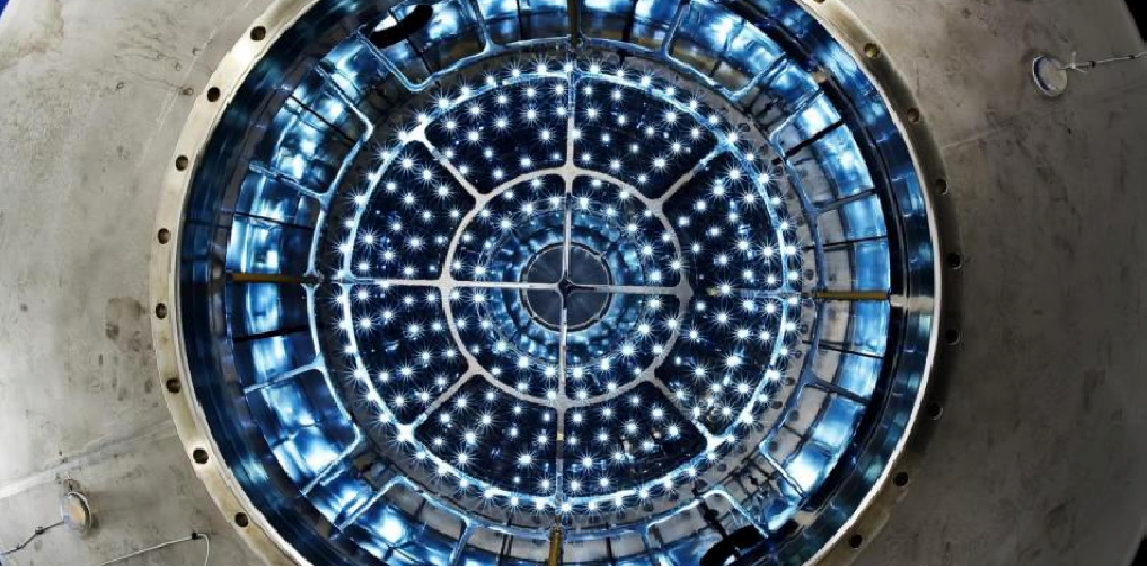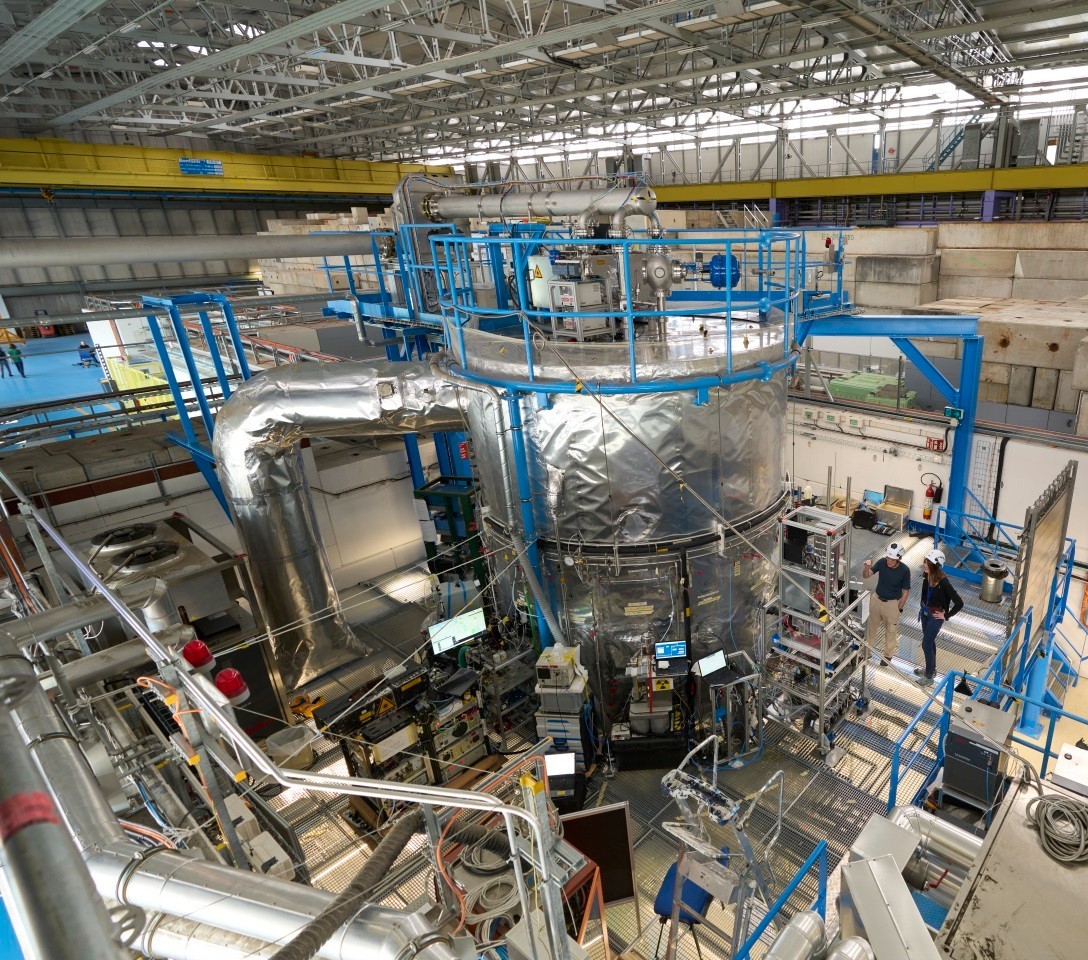CLOUD experiment
What is CLOUD?
Why do we grow bananas at CERN? Check out this link to a short video narrated by Ruby Marten a PSI Marie-Curie PhD fellow.
Super-saturated vapors in the atmosphere can nucleate to form new liquid or solid aerosol particles. These particles are seeds for cloud droplets and without them our planet would be much hotter, and without life. We thus owe our existence to aerosols. The CLOUD experiment (Cosmics Leaving OUtdoor Droplets) at CERN is the world first and only laboratory experiment to reach the demanding technical performance and ultralow contaminant levels required to measure new particle formation (NPF) under controlled atmospherically relevant conditions.
At the heart of the experiment is an advanced cloud chamber whose contents is continuously analyzed with a suite of external instrumentation. The chamber is an electropolished stainless steel cylinder with a volume of 26.1 m3, situated at the European Organization for Nuclear Research (CERN). The main feature of the chamber is the extraordinarily precise control over physical and chemical conditions. The temperature conditions anywhere in the atmosphere can be recreated within the chamber, with temperature variations less than 0.1 K. CERN's Proton Synchrotron provides an artificial source of cosmic rays that simulates natural conditions between ground level and the stratosphere, allowing the investigation of the influence of our sun on NPF. Liquid or ice clouds can be created in the chamber, by controlling the pressure and performing rapid adiabatic expansions. Atmospheric vapors, including aerosol and oxidant precursors are injected into the chamber trough dedicated stainless steel lines, avoiding cross contaminations. Atmospheric chemistry inside the chamber is controlled using a series of UV and visible lights.
All experimental conditions inside the chamber can be precisely measured, including the cosmic ray intensity, the light intensity and the trace atmospheric vapors in the chamber, which are set to levels of only a few molecules per trillion. A suite of high resolution mass spectrometers measure the chemical composition of nucleating vapors, clusters and particles, while state-of-the-art particle sizers measure the number size distribution of the evolving aerosol population. Resulting nucleation and growth rates are calculated and compared to the concentration of nucleating vapors to derive simple parameterizations for climate model projections.
What did we learn from CLOUD ?
Since its inception in 2009, CLOUD has provided an unprecedented understanding of the molecular processes involved in atmospheric particle formation and growth, and systematically measured formation and growth rates over a wide range of atmospheric conditions. CLOUD has now identified key atmospheric vapors that contribute to particle formation. They comprise sulfuric acid, highly oxygenated organic molecules, iodine oxo-acids, and nitric acid. Some of these vapors are often insufficient to nucleate alone, and require additional stabilizing species such as bases or ions. These few statements would not have been possible before CLOUD started, making CLOUD one of the most successful long-term atmospheric chemistry experiment ever run. CLOUD experimental data are parameterized and implemented in models to improve the representation of aerosols, clouds and climate predictions.
What is the role of PSI in the CLOUD consortium?
The pillar on which the CLOUD experiment is built is research at CERN. CERN was conceived to build bridges between nations through science, and is an inspiring model of international collaboration. Today, around 15,000 scientists from more than 100 different countries join at CERN towards common scientific goals, regardless of any political, social or religious differences that their nations may have. CLOUD is the only atmospheric chemistry experiment that follows CERN’s model: it involves an interdisciplinary consortium of 23 institutes from 15 European countries and the U.S., with more than 100 researchers working jointly on the experiment. As such, the experiment has been an outstanding training platform for several generations of students, postdocs and young scientists. Switzerland has an especially high profile on CLOUD through the PSI and CERN partners. The PSI team is one of the four pillars of CLOUD and has been since the very start of the experiment. PSI is a member of the Steering Committee who is responsible for making the executive decisions on the experiment and steering it scientifically, technically and administratively. The PSI team has led several of the most important discoveries made at CLOUD, in particular on the role of organic vapors for NPF.
Contact: Imad El Haddad
What is next for CLOUD?
The CLOUD experiment will recreate particle formation in key regions of the globe to sharpen projections of future climate from local to global scales.
In their latest report, the IPCC asserted that global warming is due to greenhouse gases, with this effect partly masked by aerosols. Climate change will affect us enormously. The one degree Celsius increase that our planet has already experienced represents an average global value, while land areas have already undergone much greater warming – e.g. in Switzerland we are measuring a temperature increase of 2 degrees Celsius. This is a key strength of this IPCC report: it looks at climate change on a regional basis, where aerosols may have much more important effects on local climate and weather. The CLOUD consortium will focus on recreating the atmospheric conditions found in specific regions of the globe, including the upper troposphere, polar regions, open ocean and urban areas (e.g. China and India). A key principle of CLOUD is that it is closely tied to the real atmosphere. The PSI team takes advantage of their atmospheric observations within ACTRIS observatories and in polluted areas like in China and India for a faithful representation of atmospheric conditions at CLOUD. In the next 10 years, CLOUD will provide the basic experimental data that models need with which to understand climate change and its progression regionally.
CLOUD in PSI media
Running projects
CLOUD has created more than 35 MCHF in funding, with PSI contributing to ~5MCHF as second party funds. Below is a list of running projects led by PSI.
Publications
A full publication list can be found here. Below is a selection of key publications.
-
Kirkby J, Curtius J, Almeida J, Dunne E, Duplissy J, Ehrhart S, et al.
Role of sulphuric acid, ammonia and galactic cosmic rays in atmospheric aerosol nucleation
Nature. 2011; 476(7361): 429-435. https://doi.org/10.1038/nature10343
DORA PSI
-
Almeida J, Schobesberger S, Kürten A, Ortega IK, Kupiainen-Määttä O, Praplan AP, et al.
Molecular understanding of sulphuric acid-amine particle nucleation in the atmosphere
Nature. 2013; 502(7471): 359-363. https://doi.org/10.1038/nature12663
DORA PSI
-
Schobesberger S, Junninen H, Bianchi F, Lönn G, Ehn M, Lehtipalo K, et al.
Molecular understanding of atmospheric particle formation from sulfuric acid and large oxidized organic molecules
Proceedings of the National Academy of Sciences of the United States of America PNAS. 2013; 110(43): 17223-17228. https://doi.org/10.1073/pnas.1306973110
DORA PSI
-
Kürten A, Jokinen T, Simon M, Sipilä M, Sarnela N, Junninen H, et al.
Neutral molecular cluster formation of sulfuric acid-dimethylamine observed in real time under atmospheric conditions
Proceedings of the National Academy of Sciences of the United States of America PNAS. 2014; 111(42): 15019-15024. https://doi.org/10.1073/pnas.1404853111
DORA PSI
-
Riccobono F, Schobesberger S, Scott CE, Dommen J, Ortega IK, Rondo L, et al.
Oxidation products of biogenic emissions contribute to nucleation of atmospheric particles
Science. 2014; 344(6185): 717-721. https://doi.org/10.1126/science.1243527
DORA PSI
-
Gordon H, Sengupta K, Rap A, Duplissy J, Frege C, Williamson C, et al.
Reduced anthropogenic aerosol radiative forcing caused by biogenic new particle formation
Proceedings of the National Academy of Sciences of the United States of America PNAS. 2016; 113(43): 12053-12058. https://doi.org/10.1073/pnas.1602360113
DORA PSI
-
Dunne EM, Gordon H, Kürten A, Almeida J, Duplissy J, Williamson C, et al.
Global atmospheric particle formation from CERN CLOUD measurements
Science. 2016; 354(6316): 1119-1124. https://doi.org/10.1126/science.aaf2649
DORA PSI
-
Lehtipalo K, Rondo L, Kontkanen J, Schobesberger S, Jokinen T, Sarnela N, et al.
The effect of acid-base clustering and ions on the growth of atmospheric nano-particles
Nature Communications. 2016; 7: 11594 (9 pp.). https://doi.org/10.1038/ncomms11594
DORA PSI
-
Tröstl J, Chuang WK, Gordon H, Heinritzi M, Yan C, Molteni U, et al.
The role of low-volatility organic compounds in initial particle growth in the atmosphere
Nature. 2016; 533(7604): 527-531. https://doi.org/10.1038/nature18271
DORA PSI
-
Kirkby J, Duplissy J, Sengupta K, Frege C, Gordon H, Williamson C, et al.
Ion-induced nucleation of pure biogenic particles
Nature. 2016; 533(7604): 521-526. https://doi.org/10.1038/nature17953
DORA PSI
-
Stolzenburg D, Fischer L, Vogel AL, Heinritzi M, Schervish M, Simon M, et al.
Rapid growth of organic aerosol nanoparticles over a wide tropospheric temperature range
Proceedings of the National Academy of Sciences of the United States of America PNAS. 2018; 115(37): 9122-9127. https://doi.org/10.1073/pnas.1807604115
DORA PSI
-
Lehtipalo K, Yan C, Dada L, Bianchi F, Xiao M, Wagner R, et al.
Multicomponent new particle formation from sulfuric acid, ammonia, and biogenic vapors
Science Advances. 2018; 4(12): eaau5363 (9 pp.). https://doi.org/10.1126/sciadv.aau5363
DORA PSI
-
Yan C, Nie W, Vogel AL, Dada L, Lehtipalo K, Stolzenburg D, et al.
Size-dependent influence of NOx on the growth rates of organic aerosol particles
Science Advances. 2020; 6(22): eaay4945 (9 pp.). https://doi.org/10.1126/sciadv.aay4945
DORA PSI
-
Wang M, Kong W, Marten R, He X-C, Chen D, Pfeifer J, et al.
Rapid growth of new atmospheric particles by nitric acid and ammonia condensation
Nature. 2020; 581(7807): 184-189. https://doi.org/10.1038/s41586-020-2270-4
DORA PSI
-
He X-C, Tham YJ, Dada L, Wang M, Finkenzeller H, Stolzenburg D, et al.
Role of iodine oxoacids in atmospheric aerosol nucleation
Science. 2021; 371(6529): 589-595. https://doi.org/10.1126/science.abe0298
DORA PSI
-
Wang M, Xiao M, Bertozzi B, Marie G, Rörup B, Schulze B, et al.
Synergistic HNO3-H2SO4-NH3 upper tropospheric particle formation
Nature. 2022; 605(7910): 483-489. https://doi.org/10.1038/s41586-022-04605-4
DORA PSI
-
Finkenzeller H, Iyer S, He X-C, Simon M, Koenig TK, Lee CF, et al.
The gas-phase formation mechanism of iodic acid as an atmospheric aerosol source
Nature Chemistry. 2023; 15: 129-135. https://doi.org/10.1038/s41557-022-01067-z
DORA PSI
-
Nie W, Yan C, Yang L, Roldin P, Liu Y, Vogel AL, et al.
NO at low concentration can enhance the formation of highly oxygenated biogenic molecules in the atmosphere
Nature Communications. 2023; 14(1): 3347 (11 pp.). https://doi.org/10.1038/s41467-023-39066-4
DORA PSI
-
Dada L, Stolzenburg D, Simon M, Fischer L, Heinritzi M, Wang M, et al.
Role of sesquiterpenes in biogenic new particle formation
Science Advances. 2023; 9(36): eadi5297 (15 pp.). https://doi.org/10.1126/sciadv.adi5297
DORA PSI

